Botanical Name: Abeliophyllum distichum
Common Name: white forsythia
Family: Oleaceae
Distribution/Origin: Korea
Leaf: ovate, green, simple, entire margins
Bud: opposite
Flower: dense axillary racemes, white, yellow stamens, blooms March-April
Fruit/Seed: round, winged samara
Stem/Bark: multi stemmed, smooth, brown to grey
Size: 3-5’ height, 3-5’ spread
Habit: arching, twiggy
Form: vase, has to be pruned to keep form
Soil conditions: average, well drained
Moisture: medium
Sun: full sun to partial shade
Exposure: grows best in sunny positions though blooms may be damaged by frost in early season. Doesn’t enjoy drought or waterlogged conditions.
Landscape use: shrub borders, spring interest garden, best not planted in prominent location as it loses its interest once flowers are done blooming
Notes: good cut flowers. Endangered in native habitat (Korea), similar in medicinal properties comparable to witch hazel it is largely harvested and sold in the black market. Because of its popularity for a gardening plant it is not in danger of going extinct except in the wild.

Botanical Name: Camellia japonica
Common Name: common camellia, Japanese camellia
Family: Theaceae
Distribution/Origin: SE Asia, Japan, China
Leaf: simple, leathery texture, glabrous, elliptic, serrated margins
Bud: alternate
Flower: floriferous solitary flowers, pink to red, multi petalled, multi stamens
Fruit/Seed: brown to red capsule, large brown seeds
Stem/Bark: brown, lightly fissured
Size: 10-20’ height, 10-13’ spread
Habit: dense, upright
Form: oval, vertical
Soil conditions: acidic, well drained, fertile, rich with organic matter
Moisture: high
Sun: part sun to part shade
Exposure:
Landscape use: accent plant, cut flower or foliage, spring interest, tall background
Notes:
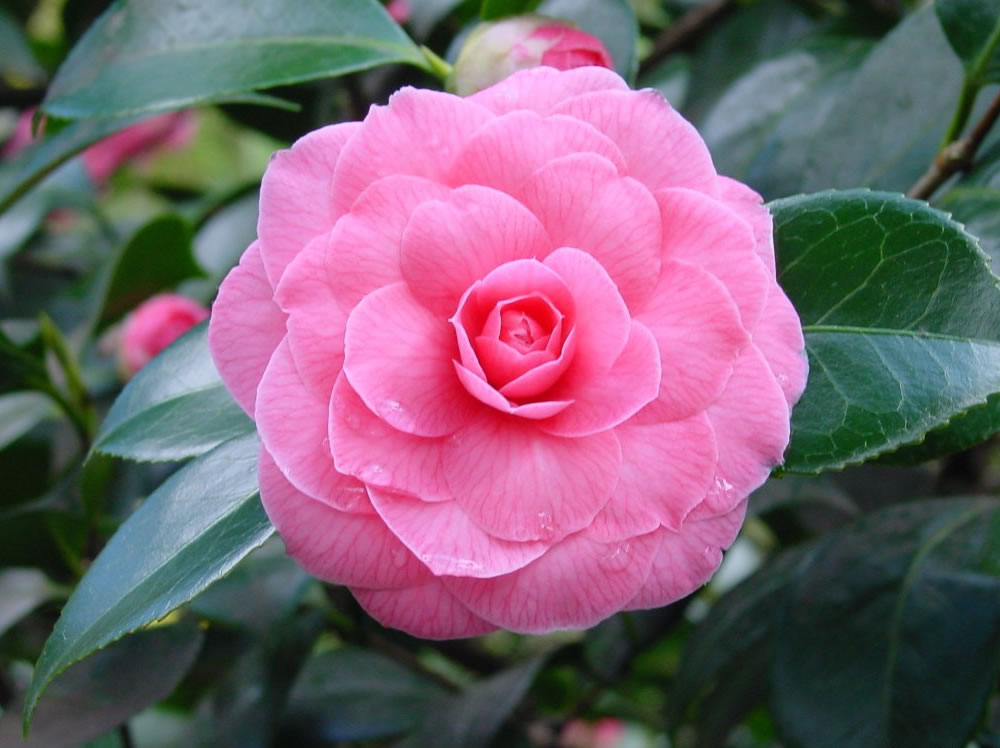



Botanical Name: Camellia sasanqua
Common Name: sasanqua camellia
Family: Theaceae
Family: Theaceae
Distribution/Origin: China, Japan
Leaf: elliptic, lustrous dark green, crenulate serrate margins, simple
Bud: alternate
Flower: solitary, white to red, showy, blooms Oct-Dec
Fruit/Seed: capsule containing 2-5 seeds
Stem/Bark: stems are pubescent, smooth grey to brown
Size: 10-15’ height. 5-10’ spread
Habit: spreading, upright, dense
Form: oval, vertical, pyramidal
Soil conditions: acidic, well drained, rich loamy sands
Moisture: low to moderate
Sun: full sun to partial shade
Exposure: sheltered
Landscape use: container planting, mixed shrub border, specimen plant, winter interest
Notes:
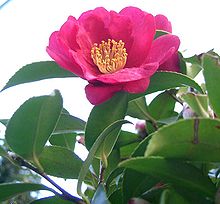



Botanical Name: Camellia sinensis
Common Name: tea plant, tea shrub
Family: Theaceae
Distribution/Origin: East Asia, South East Asia
Leaf: elliptic to ovate, pubescent undersides, green, serrate margins
Bud: alternate
Flower: solitary or grouped, 7-8 petals, fragrant
Fruit/Seed: brownish green capsules containing 1-4 seeds
Stem/Bark: rough, grey to brown
Size: up to 13’ height & 8’ spread
Habit: upright
Form: rounded
Soil conditions: sandy loams, well drained, acidic
Moisture: moist
Sun: full sun to partial shade
Exposure: more tolerant of drought than other members of Theaceae family
Landscape use: woodland garden, sunny edge, dappled shade, shady edge
Notes: fresh leaves contain about 4% caffeine
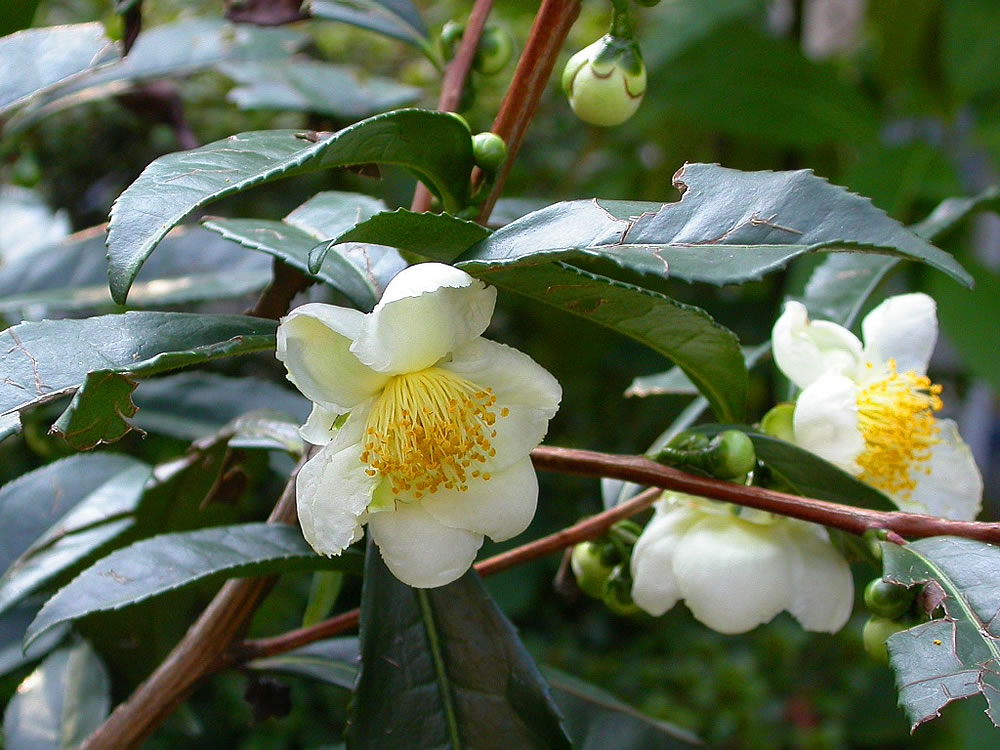



Botanical Name: Camellia x williamsii
Common Name: Williams camellia, rose of winter
Family: Theaceae
Distribution/Origin: garden origin
Leaf: ovate, glossy green
Bud: alternate
Flower: double blooms, pink
Fruit/Seed:
Stem/Bark: lightly textured, brown to grey
Size: 8-15’ height, 6-8’ spread
Habit: upright, vigorous, twiggy
Form: narrowly rounded
Soil conditions: well drained, acidic, humus-rich
Moisture: moist
Sun: full sun to partial shade
Exposure: keep moist in first years of planting to ensure it may establish
Landscape use: containers, beds, spring interest, mixed shrub borders, scent garden
Notes:




Botanical Name: Daphne odora
Common Name: winter daphne
Family: Thymelaeaceae
Distribution/Origin: China, Japan, Korea
Leaf: simple, obovate to elliptic, glossy green
Bud: alternate
Flower: fleshy, pale pink, 4 spreading lobes, tubular
Fruit/Seed: red berries, rarely fruits
Stem/Bark: smooth, brown to red
Size: 3-4’ height, 2-4’ spread
Habit: bushy
Form: rounded
Soil conditions: fertile, humusy, slightly acidic, sharply drained
Moisture: moist
Sun: full sun to partial shade
Exposure: Does not transplant well. Keep sheltered from cold winter winds and cold.
Landscape use: woodland garden, dappled shade, ground cover, hedge
Notes: In Korea, the plant is also poetically called "chunhyang" - a thousand mile scent - referring to the fragrance of the foliage. Plants not long lived, 8-10 years. Sap can cause irritation. Potential diseases include botrytis, leaf spots, canker, twig blight, crown rot, root rot and virus.

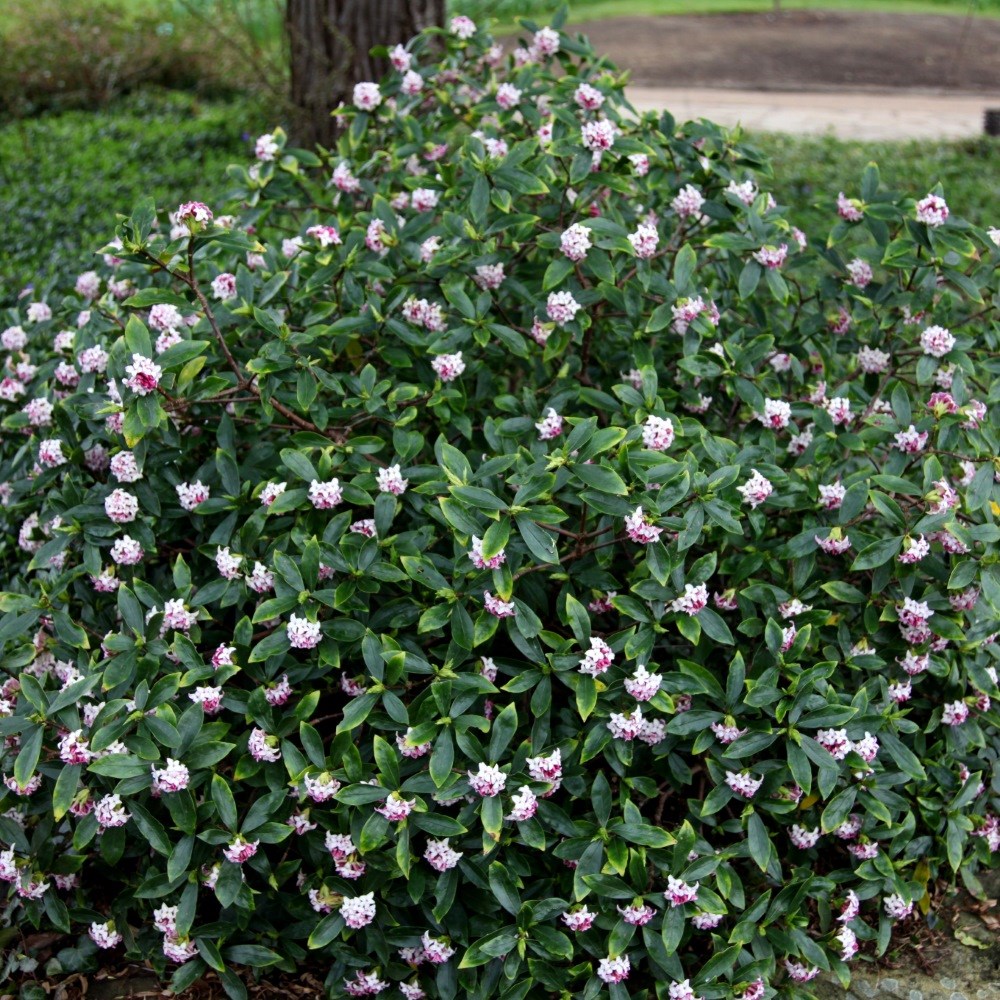


Botanical Name: Deutzia gracilis 'Nikko'
Common Name: slender deutzia
Family: Hydrangeaceae
Distribution/Origin: SE Asia, Japan/China
Leaf: simple, pinnate venation, glabrous surfaces, lanceolate to ovate, serrated margins with rounded bases
Bud: opposite
Flower: floriferous racemes, white, perfect, 5 petaled, May-June
Fruit/Seed: brown capsules
Stem/Bark: brown to grey, lightly textured
Size: 2-4’ height, 2-3’ spread
Habit: dense, arching, spreading
Form: rounded
Soil conditions: humusy, average, well drained
Moisture: moist
Sun: full sun to partial shade
Exposure:
Landscape use: shrub borders, foundations, open woodland areas, informal hedge
Notes:
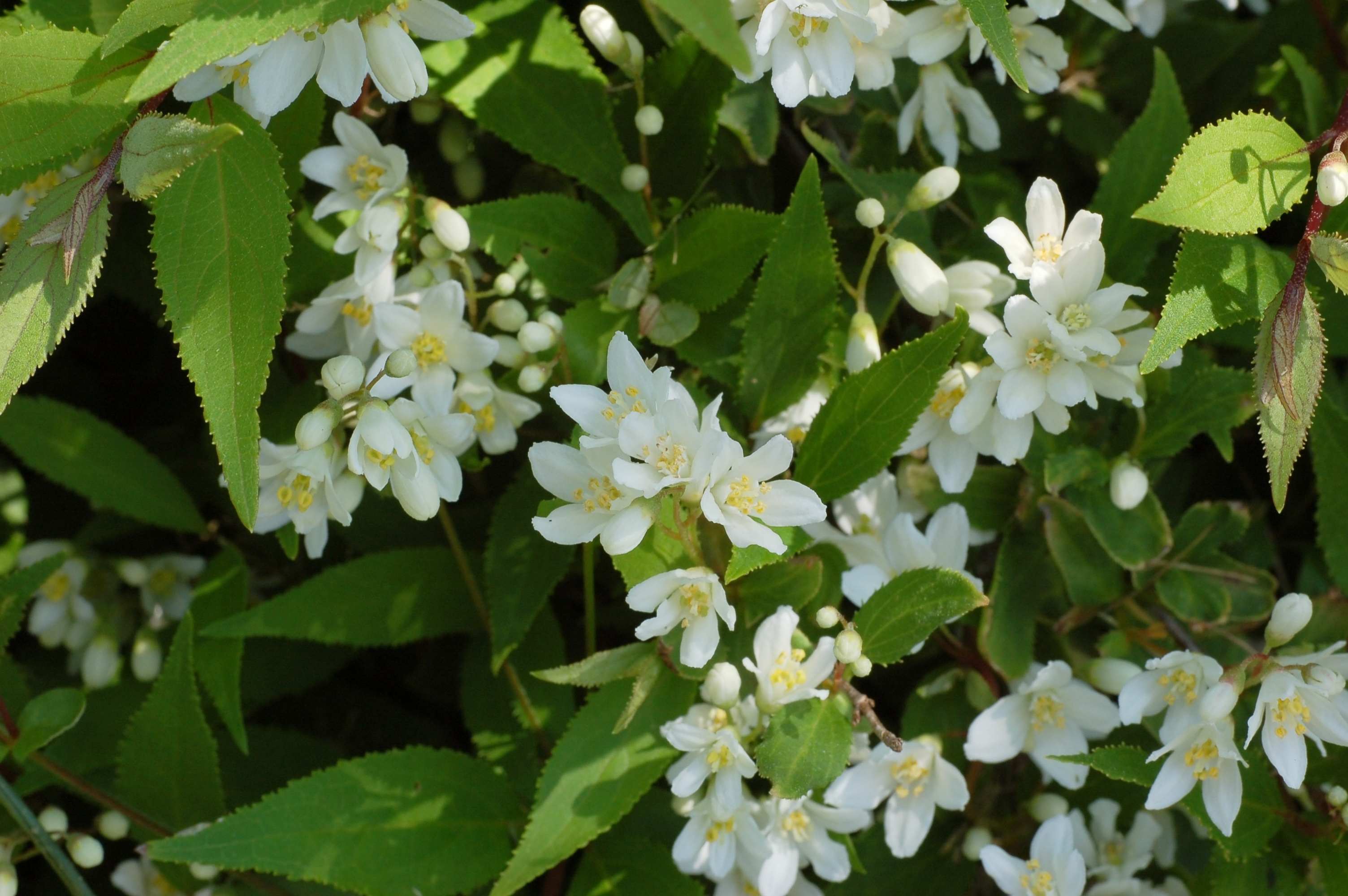



Botanical Name: Garrya elliptica
Common Name: silk tassel bush
Family: Garryaceae
Distribution/Origin: north western US
Leaf: elliptic, leathery texture, rounded base, undulated entire margins, dark green
Bud: opposite
Flower: diecious, catkins (male), white, female plants solitary (separate plant), Jan-March
Fruit/Seed: purple to black berries
Stem/Bark: red to brown, lightly fissured, prominent lenticels
Size: 6-10’ height, 6-10’ spread
Habit: dense
Form: round, weeping
Soil conditions: humus rich, well drained
Moisture: moderate
Sun: full sun
Exposure:
Landscape use: screening, winter interest, attracts birds, mixed shrub border
Notes:




Botanical Name: Lonicera x brownii 'Dropmore Scarlet'
Common Name: scarlet trumpet honeysuckle
Family: Caprifoliaceae
Distribution/Origin: garden origin, North America
Leaf: simple, elliptic to ovate, entire margins, truncate bases
Bud: opposite
Flower: spike like clusters, perfect, showy orange to red, blooms July-Sep
Fruit/Seed: true berry, orange to red
Stem/Bark: exfoliating, brown
Size: 10-16’ height, 5-7’ spread
Habit: upright, twining, climbing
Form: round, mounding
Soil conditions: well drained
Moisture: moderate
Sun: full sun
Exposure:
Landscape use: arbor or trellis, attracts birds, butterflies, screening
Notes:



Botanical Name: Kalmia latifolia
Common Name: mountain laurel
Family: Ericaceae
Distribution/Origin: north eastern US
Leaf: elliptic, glossy dark green, smooth margins, alternate/whorled at tip
Bud: opposite
Flower: corymb like cymes, showy, white pink to red, clustered, cup shaped, blooms May-June, sweetly scented
Fruit/Seed: brown capsule
Stem/Bark: exfoliating, dark grey to brown
Size: 7-10’ height, 13-16’ spread
Habit: spreading
Form: oval-horizontal, round
Soil conditions: acidic, well drained, gravelly sands
Moisture: moderate
Sun: part sun/shade
Exposure: tolerates wet to moist soils
Landscape use: cut flower or foliage, mixed shrub border, woodland margin
Notes:




Botanical Name: Lonicera nitida
Common Name: boxleaf honeysuckle
Family: Caprifoliaceae
Distribution/Origin: garden origin
Leaf: simple, leathery texture, green, elliptic to oblong-ovate, entire margins
Bud: opposite
Flower: tubular, paired, perfect, showy white
Fruit/Seed: blue to purple berry
Stem/Bark: smooth grey to brown
Size: 4-7’ height, 5-7’ spread
Habit: arching
Form: irregular, mounding
Soil conditions: well drained, fertile
Moisture: moderate
Sun: full sun to part sun/shade
Exposure:
Landscape use: spreading groundcover, accent plant, hedgerow, wildlife attractant
Notes: often used for bonsai




Botanical Name: Lonicera pileata
Common Name: privet honeysuckle
Family: Caprifoliaceae
Distribution/Origin: SE Asia, Japan, China
Leaf: leathery texture, lanceolate to oblanceolate, entire margins, bright green
Bud: opposite
Flower: paired, perfect, funnel form, white to yellow, April-May
Fruit/Seed: violet to purple berries
Stem/Bark: brown, exfoliating, multi stemmed trunk
Size: 1-3’ height, 6-10’ spread
Habit: horizontal, spreading, stiffly upright
Form: round
Soil conditions: well drained
Moisture: moderate
Sun: full sun to partial shade
Exposure: drought resistant
Landscape use: erosion control, mixed shrub border, filler, ground cover, group or mass planting, small garden space, spring interest
Notes:




Botanical Name: Lonicera x purpusii
Common Name: shrubby honeysuckle
Family: Caprifoliaceae
Distribution/Origin: garden origin
Leaf: ovate, dark green with glaucous undersides, entire margins
Bud: alternate
Flower: tubular to funnel shaped, cream white with pale yellow anthers, Dec-April
Fruit/Seed: red drupes, often aborted
Stem/Bark: warm brown bark
Size: up to 7’ height and 7-8’ spread
Habit: dense, upright
Form: rounded
Soil conditions: well drained, loamy, humus rich
Moisture: moist to dry
Sun: full sun to partial shade
Exposure: tolerant of most pHs with some drought tolerance
Landscape use: shrubby borders, scent garden, attracts beneficials, woodland margin
Notes: prune after flowering, richly scented
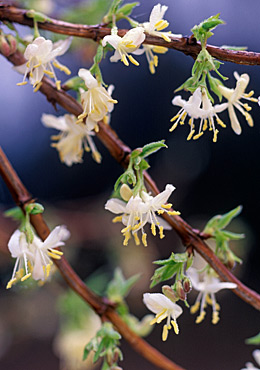



Botanical Name: Spiraea douglasii
Common Name: hardhack
Family: Rosaceae
Distribution/Origin: North America
Leaf: simple, pinnate venation, dark green with pale and wooly undersides, oblong shape, toothed above middle of blade
Bud: alternate
Flower: floriferous panicle, very showy, pink, blooms June-July
Fruit/Seed: brown follicle
Stem/Bark: smooth, tan to brown
Size: 4-7’ height, 6-13’ spread
Habit: stiffly upright, twiggy
Form: oval-vertical
Soil conditions: acidic, heavy
Moisture: wet
Sun: full sun
Exposure: tolerant of heavy clay soils and wet areas
Landscape use: erosion control, summer interest, waterside planting, wildlife food, woodland margin
Notes:




Botanical Name: Spiraea japonica
Common Name: Japanese spirea
Family: Rosaceae
Distribution/Origin: Japan
Leaf: simple, ovate to lanceolate, serrated margins, pinnate venation, pubescent surfaces
Bud: alternate
Flower: perfect, corymbs, showy white to pink, blooms April-June
Fruit/Seed: brown follicle
Stem/Bark: brown to red, smooth
Size: 4-6’ height, 3-5’ spread
Habit: dense, twiggy
Form: mounded, oval-horizontal
Soil conditions: humus rich, well drained
Moisture: dry to wet
Sun: full sun to partial shade
Exposure:
Landscape use: accent plant, group or mass planting, hedge row, mixed border, small garden space, summer interest
Notes:



Botanical Name: Spiraea nipponica
Common Name: snowmound
Family: Rosaceae
Distribution/Origin: Japan
Leaf: elliptical to narrowly ovate, blue green, minimal petiole, sparsely serrated
Bud: alternate
Flower: perfect, floriferous corymbs, showy white, blooms May-June
Fruit/Seed: green to brown follicles
Stem/Bark: dark brown to burgundy, exfoliating
Size: 2-5’ height, 3-5’ spread
Habit: arching, spreading
Form: compact, vase
Soil conditions: well drained, adaptable to poor soils
Moisture: dry to moist
Sun: full sun to partial shade
Exposure: tolerant of drought, heavy pruning, urban conditions
Landscape use: mixed shrub border, spring interest, beds, group planting, informal hedge, foundation shrub
Notes:




Botanical Name: Spiraea x vanhouttei
Common Name: bridal wreath spirea
Family: Rosaceae
Distribution/Origin: Europe
Leaf: heavily veined, pubescent surfaces, ovate, green
Bud: alternate
Flower: white corymbs
Fruit/Seed: follicle, insignificant
Stem/Bark: brown, smooth
Size: 6-10’ height, 6-10’ spread
Habit: arching
Form: oval-horizontal, round
Soil conditions: well drained, adaptable as long as moist, average
Moisture: moderate - moist
Sun: full sun to partial shade
Exposure:
Landscape use: mixed shrub borders, naturalized areas, beds, borders, patio and decks
Notes:




Botanical Name: Syringa meyeri
Common Name: Meyers lilac
Family: Oleaceae
Distribution/Origin: northern China
Leaf: broad elliptic to ovate, dark green
Bud: opposite
Flower: purple, dense panicles, terminal clusters
Fruit/Seed: capsule
Stem/Bark: brown to grey, smooth, lenticels present
Size: 5-8’ height, 6-10’ spread
Habit: compact
Form: rounded
Soil conditions: organically rich, acidic to alkaline, well drained
Moisture: moist
Sun: full sun
Exposure: needs good air circulation
Landscape use: specimen, street tree, garden space, massed, shrub borders, foundations, screening
Notes: extremely resistant to powdery mildew, flower buds are susceptible to frost injury in the spring




Botanical Name: Syringa reticulata
Common Name: Japanese lilac tree
Family: Oleaceae
Distribution/Origin: Japan
Leaf: elliptic acute, entire margins, rough texture and slightly impressed veins
Bud: opposite
Flower: creamy white panicles, strong fragrance
Fruit/Seed: dry brown capsule, splitting to release 2 winged seed
Stem/Bark: reddish brown, lenticels present
Size: 15-20’ height, 10-15’ spread
Habit: dense branching, upright
Form: rounded, oval
Soil conditions: adaptable to even poor soils, prefers organically rich, well drained
Moisture: moist to dry
Sun: full sun
Exposure: salt tolerant, deer resistant
Landscape use: specimen, street tree, naturalized areas, mixed borders, fragrance garden, lawns, gardens, patios/decks
Notes: may develop powdery mildew in hot and humid weather. Prune as needed immediately after flowering.




Botanical Name: Syringa vulgaris
Common Name: common lilac
Family: Oleaceae
Distribution/Origin: Europe, naturalized in North America
Leaf: simple, ovate, glabrous surfaces, entire to sinuate margins, bright green, whorls of 3
Bud: opposite
Flower: floriferous panicles, fragrant, showy, violet (varies with cultivar), perfect, April-May
Fruit/Seed: brown capsule
Stem/Bark: smooth, multi stemmed, grey to olive brown, older wood exfoliates
Size: 15-20’ height, 8-15’ spread
Habit: stiffly upright
Form: irregular
Soil conditions: alkaline, well drained, humus rich
Moisture: moderate
Sun: full sun
Exposure:
Landscape use: attracts wildlife, cut flower or foliage, scent garden, hedgerow, screening, specimen plant
Notes:




No comments:
Post a Comment